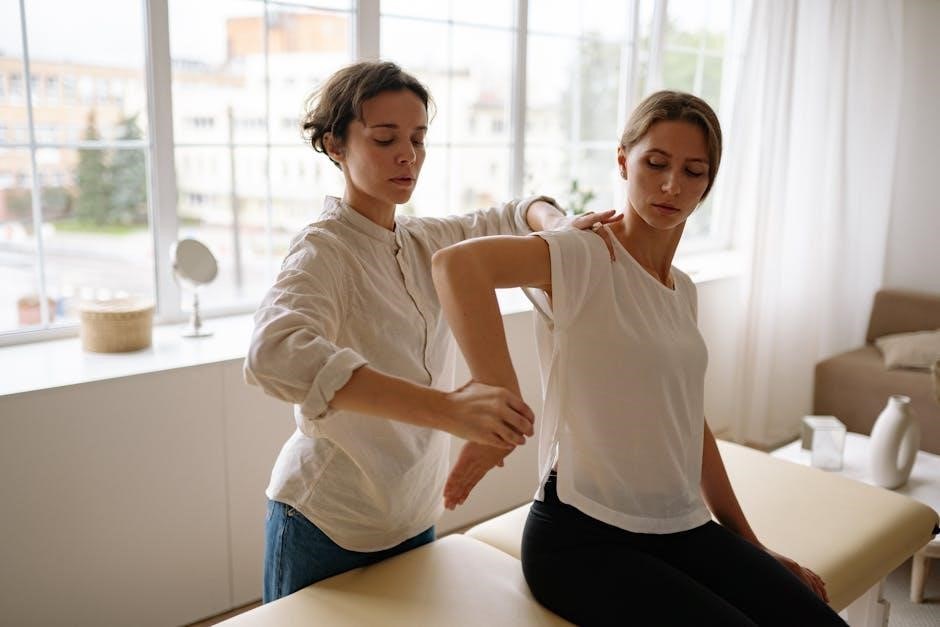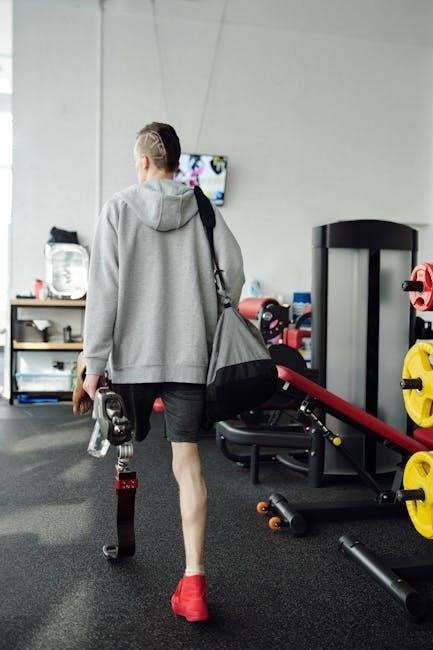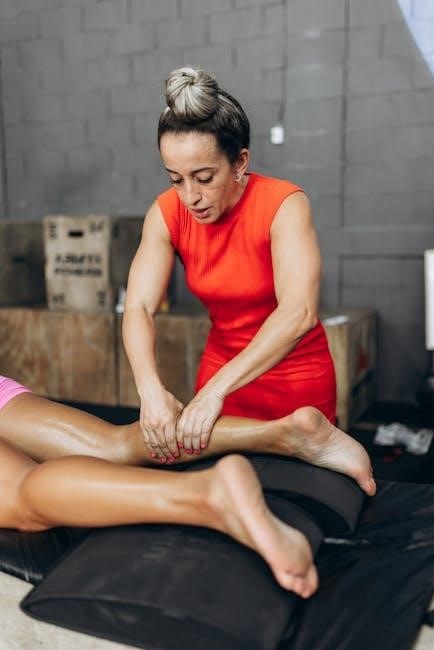LCL rehab exercises are crucial for recovery, focusing on passive ROM, strengthening, and proprioceptive training across multiple phases to restore function and prevent future injuries effectively.
Overview of LCL Injuries and Rehabilitation
LCL injuries are less common than other knee ligament tears but often occur alongside additional ligament damage. Rehabilitation focuses on restoring knee stability, strength, and function through structured exercises. The process typically includes passive range of motion, strengthening, and proprioceptive training. Nonoperative treatment is suitable for grade I and II tears, while grade III tears require surgery. Rehabilitation is criterion-based, progressing from immobilization to weight-bearing exercises over 2-6 months. Proper adherence to protocols ensures optimal recovery, preventing long-term complications and restoring athletic or daily activity levels effectively.
Understanding the Lateral Collateral Ligament (LCL)
The LCL, located on the outer knee, connects the femur to the tibia, providing lateral stability and preventing excessive outward knee movement, essential for proper joint function and mobility.
Anatomy and Function of the LCL
The lateral collateral ligament (LCL) is a fibrous band located on the outer aspect of the knee, connecting the femur (thigh bone) to the tibia (shin bone). It plays a critical role in stabilizing the knee joint, preventing excessive outward movement and providing lateral support. The LCL is less commonly injured compared to other knee ligaments, but when it is, it often occurs alongside other injuries, such as tears to the ACL or meniscal damage. Its primary function is to maintain joint alignment and facilitate smooth, controlled movements, making it essential for activities like walking, running, and pivoting.
Common Causes of LCL Injuries
LCL injuries often result from direct blows to the inner knee or excessive outward bending of the knee joint. Sports involving sharp pivots or collisions, such as football or skiing, increase the risk. Traumatic falls or twisting injuries can also cause LCL tears. Additionally, sudden stops or changes in direction during high-impact activities may lead to ligament strain. Isolated LCL injuries are rare, frequently occurring alongside other knee injuries, such as ACL tears or meniscal damage, complicating the recovery process and emphasizing the need for comprehensive rehabilitation strategies.
Importance of Rehabilitation for LCL Injuries
Rehabilitation is essential for restoring function, preventing future injuries, and reducing pain. It strengthens surrounding muscles and improves joint stability, ensuring a safe return to daily activities and sports.
Goals of LCL Rehabilitation
The primary goals of LCL rehabilitation are to restore knee stability, improve range of motion, and strengthen surrounding muscles. These objectives ensure proper healing, reduce pain, and prevent future injuries. Additionally, rehabilitation aims to enhance functional activities and allow a safe return to sports or daily activities. Achieving these goals involves a structured approach, including passive exercises, progressive strengthening, and proprioceptive training. Each phase is designed to address specific aspects of recovery, ensuring the knee regains optimal function and stability over time. Consistency in following the rehabilitation protocol is key to achieving these objectives effectively.
Consequences of Inadequate Rehabilitation
Inadequate rehabilitation of LCL injuries can lead to chronic knee instability, persistent pain, and limited mobility. Without proper healing, the knee may remain weak, increasing the risk of further injuries or ligament tears. This can result in prolonged recovery, difficulty returning to sports or daily activities, and a higher likelihood of requiring surgical intervention. Additionally, insufficient rehab may lead to long-term functional deficits, making it harder to achieve full recovery. Adhering to a structured rehabilitation protocol is essential to avoid these complications and ensure optimal outcomes.
Nonoperative vs. Operative Treatment for LCL Tears
Nonoperative treatment suits minor LCL tears, focusing on bracing and rehab exercises, while operative treatment is reserved for severe tears requiring surgical reconstruction to restore stability.
Indications for Nonoperative Treatment
Nonoperative treatment is typically recommended for grade I and II LCL tears, where ligament integrity is partially preserved, and knee instability is minimal. This approach is ideal for patients with isolated LCL injuries without significant meniscal or cruciate ligament damage. It involves the use of braces to stabilize the knee, passive range of motion exercises, and avoidance of weight-bearing activities initially. Nonoperative care is also suitable for patients who are less active or have lower demands on their knee function. Early rehabilitation focuses on reducing pain, swelling, and restoring mobility while avoiding hyperextension or active knee flexion that could worsen the injury. Progression is monitored closely to ensure proper healing and prevent complications.
Indications for Surgical Intervention
Surgical intervention is typically reserved for grade III LCL tears, where the ligament is completely ruptured, leading to significant knee instability. Surgery is also indicated when LCL injuries are combined with other ligamentous or meniscal injuries, such as ACL or PLC tears, which require reconstruction for proper knee function. Patients who experience persistent instability despite nonoperative treatment or have high functional demands may also benefit from surgical repair. The goal of surgery is to restore ligament integrity, prevent further joint damage, and allow for a structured rehabilitation program to regain strength and mobility.

Phase-Based Rehabilitation Protocol for LCL Injuries
A structured, phase-based approach ensures gradual recovery, starting with passive care and progressing to strengthening and functional activities, tailored to promote healing and prevent future injuries.
Phase 1: Immediate Post-Injury Care (0-2 Weeks)
Phase 1 focuses on pain management, swelling reduction, and immobilization. A brace is typically locked in extension to protect the LCL, with non-weight-bearing activities. Passive range of motion exercises, such as gentle knee flexion and extension, are initiated to maintain joint mobility without stressing the ligament. Ankle pumps are recommended hourly to prevent stiffness and promote circulation. Active knee flexion is avoided to minimize strain on the injured ligament. This phase emphasizes rest and protection to allow the LCL to begin healing without further injury.
Phase 2: Progressive Stretching and Strengthening (6-12 Weeks)
Phase 2 introduces weight-bearing exercises and progressive resistance to enhance strength and flexibility. Gentle stretches for hamstrings and quadriceps are incorporated to improve range of motion. Strengthening exercises, such as leg presses, knee extensions, and hip exercises, are added to build muscle around the knee. Low-impact activities like swimming or cycling are recommended to maintain cardiovascular fitness without overloading the knee. This phase also includes proprioceptive training to restore balance and stability, ensuring the knee can handle daily activities and light sports movements effectively.
Phase 3: Advanced Strengthening and Functional Activities
Phase 3 focuses on advanced strengthening and functional activities to prepare for return to sport or daily activities. High-intensity resistance exercises like leg presses and step-ups are emphasized to build muscular endurance. Agility drills, such as zigzag running and shuttle runs, are introduced to improve speed and coordination. Functional tasks like single-leg balance and dynamic movements simulate real-life scenarios, enhancing proprioception and knee stability. Progression to sport-specific exercises ensures a smooth transition back to normal activities, with continuous monitoring to prevent overloading and ensure proper technique.

Key Exercises for LCL Rehabilitation
Passive ROM, strengthening, and proprioceptive exercises are essential for restoring knee function and stability, tailored to the severity of the injury to prevent future complications.
Passive Range of Motion Exercises
Passive range of motion (ROM) exercises are foundational in early LCL rehabilitation, focusing on gentle knee flexion and extension without active muscle engagement. These exercises, often performed with assistance or a towel, help maintain joint mobility and prevent stiffness. Early ROM exercises typically target 0-90 degrees, avoiding hyperextension to protect the healing ligament. Regular passive movements, such as heel slides or manual therapy, are essential for restoring functional movement and preparing the knee for progressive strengthening phases. Consistency in these exercises ensures optimal recovery and sets the stage for advanced rehabilitation protocols.
Strengthening Exercises for the Quadriceps and Hamstrings
Strengthening the quadriceps and hamstrings is vital for LCL rehabilitation, as these muscles stabilize the knee. Quad sets involve tightening thigh muscles without moving the leg, while straight leg raises strengthen the quadriceps. Hamstring exercises, like gentle curls, enhance posterior thigh strength. Leg presses and knee extensions are introduced gradually, focusing on controlled movements. These exercises improve muscle endurance and prepare the knee for weight-bearing activities. Progression to resistance bands or weights is recommended as strength increases, ensuring proper form to avoid overexertion. Stronger quadriceps and hamstrings provide critical support for the LCL during recovery and functional activities.
Proprioceptive and Balance Training
Proprioceptive and balance training is essential for restoring knee stability post-LCL injury. Single-leg stands on flat surfaces or foam pads enhance neuromuscular control. Wobble board exercises challenge balance and coordination, mimicking real-life movements. Heel-to-toe walking and balance reaches improve joint position sense. Progression includes eyes-closed exercises or unstable surfaces for advanced stability. These activities prevent chronic instability and reduce the risk of future injuries by strengthening the body’s ability to sense and adjust joint positions effectively during daily and sports-specific activities, ensuring a safer return to full function and mobility.
Agility and Functional Exercises
Agility and functional exercises are vital for restoring dynamic knee stability and preparing for return to activity. Zigzag running, figure-eight drills, and shuttle runs improve speed and directional changes. Cone drills and lateral shuffles enhance agility and reaction time. Sport-specific movements, such as cutting and pivoting, replicate real-game scenarios. These exercises are introduced in a controlled manner, progressing to more dynamic environments. Plyometric exercises, like box jumps, are added to rebuild explosive power. Functional training ensures a smooth transition to daily activities and sports, reducing the risk of reinjury by strengthening the knee’s ability to handle stress and movement effectively.

Rehabilitation Timeline and Progression
Rehabilitation progresses through phases, starting with brace use and passive movements (weeks 1-2), followed by weight-bearing exercises (weeks 3-6), and concluding with sport-specific training by weeks 7-12.
Weeks 1-2: Brace Usage and Passive Movements
During the initial phase (weeks 1-2), a hinged brace is typically used to immobilize the knee, protecting the LCL during healing. Patients are advised to avoid weight-bearing activities, relying on crutches if necessary. Passive range-of-motion exercises, such as gentle knee flexion and extension, are initiated to prevent stiffness without stressing the ligament. Ankle pumps are recommended to promote blood flow and reduce swelling. The focus is on pain management and swelling control, with ice therapy often prescribed. This period is critical for laying the foundation for successful rehabilitation by minimizing further injury and ensuring proper ligament healing.
During weeks 3-6, patients gradually transition to weight-bearing exercises while continuing to use a brace for support. Low-resistance exercises like straight leg raises and quad sets are introduced to strengthen the surrounding muscles. Passive range-of-motion exercises progress to 0-90 degrees, avoiding hyperextension. Patients may begin partial weight-bearing walking with crutches, focusing on proper gait mechanics. Gentle stretching and mobilization are incorporated to improve flexibility. The brace remains locked during weight-bearing activities to protect the LCL. This phase emphasizes building strength and stability while minimizing stress on the healing ligament. Pain should guide exercise intensity, with activities stopped if discomfort arises.
Weeks 7-12: Advanced Strengthening and Sport-Specific Training
Weeks 7-12 focus on advanced strengthening and sport-specific training to prepare for return to activity. High-intensity exercises like leg presses, step-downs, and single-leg squats are emphasized to improve strength and stability. Balance and proprioceptive drills are advanced, incorporating dynamic movements. Sport-specific agility exercises, such as shuttle runs and lateral drills, are introduced to mimic real-life movements. The brace may be weaned off as strength and confidence improve. Pain-free functional activities are prioritized, with progression tailored to individual recovery. This phase aims to restore pre-injury performance, ensuring a smooth transition back to sports or daily activities without risking re-injury.

Common Mistakes to Avoid in LCL Rehab
Common mistakes in LCL rehab include overexertion, ignoring proper brace usage, and neglecting pain management, which can delay recovery or lead to further injury.
Overexertion and Premature Return to Activity
Premature return to activity and overexertion are common mistakes that can worsen LCL injuries, leading to prolonged recovery or chronic instability. Ignoring recommended timelines for progression increases the risk of re-injury. Patients often underestimate the importance of rest and bracing during initial phases, which are critical for healing. Overloading the knee with high-impact activities too soon can strain the ligament further. Adherence to a structured rehabilitation protocol, including brace usage and gradual weight-bearing exercises, is essential to avoid setbacks. Neglecting these guidelines can result in persistent pain, limited mobility, and the need for more invasive treatments. Proper pacing ensures optimal recovery outcomes.
Ignoring Proper Brace Usage
Ignoring proper brace usage is a critical mistake during LCL rehabilitation. Braces provide essential stability and protection, especially in the early stages of recovery. Failing to use a brace or using it incorrectly can lead to excessive stress on the injured ligament, prolonging recovery and increasing the risk of further injury. Patients often underestimate the importance of compliance, but consistent brace usage, particularly during weight-bearing activities, is vital for healing. Improper brace usage can result in persistent instability, delayed healing, and the need for extended rehabilitation. Adhering to brace protocols ensures a safer and more effective recovery process for LCL injuries.
Neglecting Pain Management and Swelling Control
Neglecting pain management and swelling control can significantly hinder the LCL rehabilitation process. Persistent pain and swelling indicate ongoing inflammation, which may slow healing and worsen ligament damage. Ice therapy, elevation, and compression are essential for reducing swelling, while pain management ensures patient comfort and adherence to exercises. Ignoring these aspects can lead to prolonged recovery, increased stiffness, and potential complications. Consistent use of recommended modalities, such as ice and compression, is crucial to minimize inflammation and promote a conducive environment for ligament repair and functional recovery.
Role of Physical Therapy in LCL Rehabilitation
Physical therapy plays a vital role in LCL rehabilitation by providing expert guidance on exercise execution, utilizing therapeutic modalities like ice and heat, and ensuring proper progression.
Professional Guidance for Exercise Execution
Professional guidance is essential for proper exercise execution in LCL rehabilitation. A physical therapist designs personalized programs, ensuring exercises are performed safely and effectively. They supervise passive ROM, strengthening, and proprioceptive drills, adjusting intensity and progression based on recovery. Proper technique is emphasized to avoid further injury. Therapists also incorporate modalities like ice or heat to manage pain and swelling. Their expertise helps patients adhere to protocols, such as avoiding harmful movements during early phases. Regular visits ensure continuous improvement, making physical therapy a cornerstone of successful LCL rehab.
Use of Therapeutic Modalities (e.g., Ice, Heat)
Therapeutic modalities like ice and heat are integral to LCL rehabilitation. Ice reduces swelling and pain during acute phases, applied 15-20 minutes several times daily; Heat therapy, introduced later, promotes blood flow and relaxes muscles. Electrical stimulation may enhance strength recovery. These modalities, guided by professionals, complement exercises, accelerating recovery and improving comfort. Proper use ensures optimal healing without causing tissue damage, making them essential components of a comprehensive rehab plan tailored to each patient’s needs and progress.

Home Exercise Program for LCL Rehabilitation
A home exercise program for LCL injuries focuses on passive ROM, strengthening, and proprioceptive exercises. Regular performance of exercises like heel slides, quad sets, and straight leg raises, combined with brace use, promotes recovery and reduces pain effectively over time.
Suggested Exercises for Home Use
Home exercises for LCL rehabilitation include passive ROM, strengthening, and proprioceptive training. Heel slides, quad sets, and straight leg raises target the quadriceps and hamstrings. Ankle pumps improve circulation and reduce swelling. Gentle stretching, such as calf and hamstring stretches, enhances flexibility. For advanced stages, resistance bands or Therabands can be used for lateral leg exercises. These exercises should be performed 2-3 times daily, focusing on controlled movements and avoiding hyperextension. Consistency and proper form are essential to promote healing, strengthen the surrounding muscles, and restore knee stability effectively.
Frequency and Duration of Home Exercises
Home exercises for LCL rehabilitation should be performed 2-3 times daily, with each session lasting 20-30 minutes. During the initial phase (weeks 1-2), focus on gentle movements like ankle pumps and passive ROM, 3 sets of 10 repetitions. Progress to strengthening exercises in phase 2 (weeks 3-6), increasing resistance and repetitions as pain allows. By weeks 7-12, incorporate advanced strengthening and functional activities, maintaining consistency to ensure proper healing. Regularity and gradual progression are key to achieving optimal recovery and restoring knee function effectively without overexertion.
Monitoring Progress and Avoiding Setbacks
Track progress through pain reduction and functional improvement. Red flags include increased pain, swelling, or limited mobility, indicating potential complications or setbacks in recovery.
Signs of Progress in Rehabilitation
Signs of progress include increased range of motion, reduced pain, and improved strength. Patients may notice better functional abilities, such as walking or climbing stairs without discomfort. Strengthening exercises like straight leg raises and quad sets become easier, indicating muscle recovery. Swelling decreases, and the knee feels more stable. Gradual progression to weight-bearing activities without pain is a positive indicator. Improved balance and proprioception during exercises like single-leg stands also signal recovery. Consistent compliance with the rehab protocol and visible improvements in strength and mobility are key markers of successful rehabilitation.
Red Flags for Potential Complications
Red flags in LCL rehabilitation include increased pain, persistent swelling, or instability. Limited range of motion despite consistent exercises may indicate a complication. If pain worsens during activities or fails to improve, it signals a potential issue. Instability or giving way of the knee during weight-bearing activities is concerning. Increased bruising, warmth, or redness around the knee may suggest infection or inflammation. Failure to progress in strength or functional abilities despite adherence to the rehab protocol is another red flag. Any new or worsening symptoms should prompt immediate evaluation by a healthcare professional to avoid prolonged recovery or further injury.
